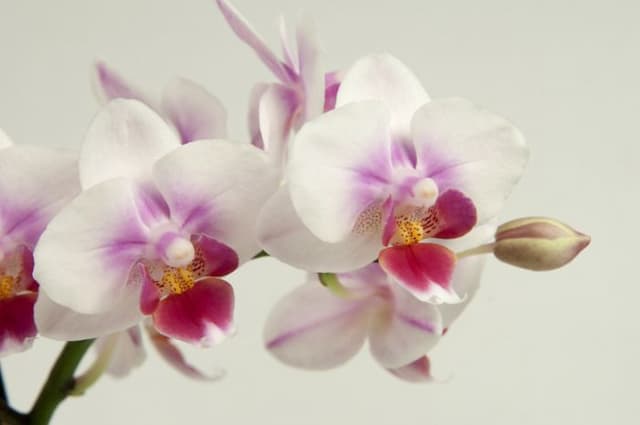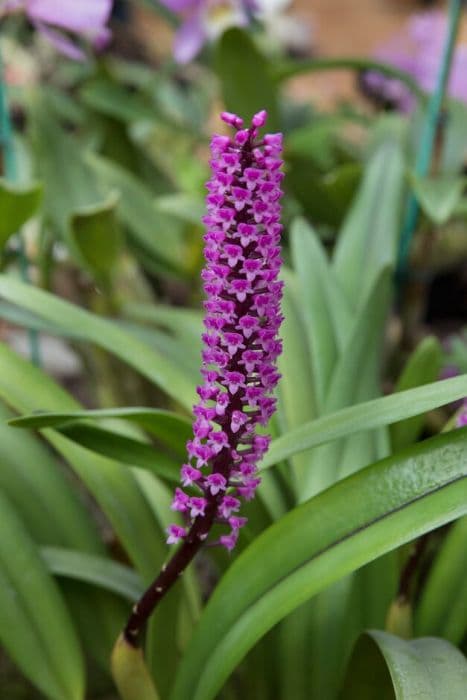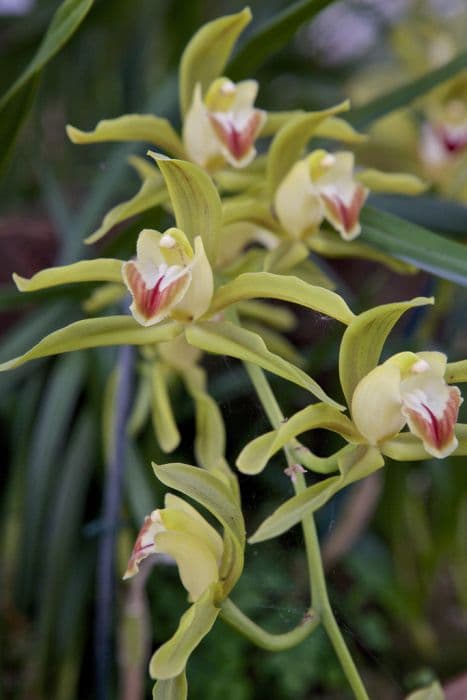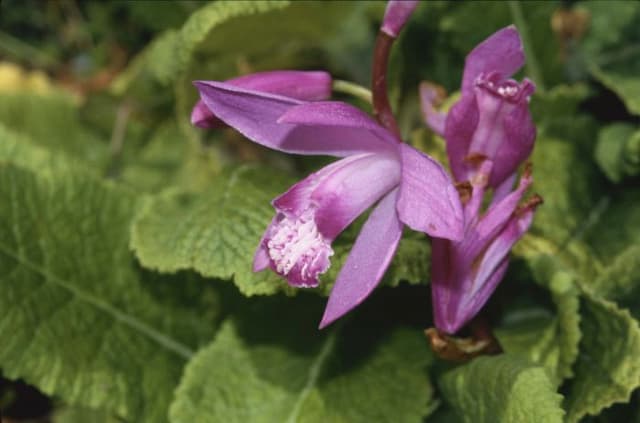Moth orchid Phalaenopsis



ABOUT
Phalaenopsis, commonly known as the moth orchid, is a type of orchid that is native to tropical Asia. They are known for their large, showy flowers, which typically bloom in shades of white, pink, yellow, and purple.
The Phalaenopsis plant has glossy green leaves that are long, narrow and leathery in texture, these leaves tend to be around 2 inches wide and 12 inches long. The leaves grow from a pseudobulb, which is a thickened stem that stores water and nutrients.
The plant blooms with spikes that can be up to 2 feet long and bear several to many large, beautiful flowers, these flowers can last for several months and the spike can have blooms for several consecutive months. Each flower can be up to 2 inches across, and they have a unique, delicate appearance with a central lip, large petals and sepals.
Phalaenopsis orchids are very popular as indoor plants due to their showy flowers and relatively easy care requirements. They can be grown in pots with well-draining potting mix, and they prefer bright, indirect light. They are also low-maintenance houseplants and they do not require regular repotting.
About this plant
 Names
NamesFamily
Orchidaceae
Synonyms
Moth orchid, Polychilos, Doritis, Synadena, Stauroglottis, Polystylus, Stauritis, Ornithochilus, Hygrochilus, Moon orchid
Common names
Polychilos, Doritis, Synadena, Stauroglottis, Polystylus, Stauritis, Ornithochilus, Hygrochilus, Kingiella, Grafia, Kingidium, Sedirea, Lesliea, Nothodoritis, Grussia
 Toxicity
ToxicityTo humans
The Phalaenopsis plant, also known as the moth orchid, is not considered toxic to humans. However, it is not generally considered edible, and consuming large quantities of the plant may cause stomach upset.
To pets
When it comes to toxicity to animals, the moth orchid is not known to be toxic to animals. There are no reports of adverse reactions in animals consuming the plant, and it is considered safe for pets and livestock.
 Characteristics
CharacteristicsLife cycle
Perennials
Foliage type
Evergreen
Color of leaves
Green
Flower color
White, pink, yellow or purple
Height
Up to 2 feet
Spread
Up to 2 feet
Plant type
Herb
Hardiness zones
9
Native area
Asia
Benefits
 General Benefits
General BenefitsThe moth orchid is known for its large, showy flowers which can last several months, this makes it a popular choice as a decorative plant. It can be used to brighten up any room or to complement any color scheme;
Moth orchids are relatively easy to care for, and they do not require regular repotting. They are well suited for people who have busy lifestyles and want a beautiful plant that does not require much attention;
They are also a sustainable crop, being tolerant to shade and requiring relatively low inputs. They are also a popular crop for reforestation projects, as well as in flower production. Medical Properties
Medical PropertiesPhalaenopsis orchids, also known as moth orchids, have been traditionally used in certain cultures for their medicinal properties. However, it is important to note that most of these uses have not been scientifically proven and are based on traditional beliefs and folk medicine.
Some research has shown that certain compounds found in the orchid, such as flavonoids and tannins, have medicinal properties. These compounds have antioxidant, anti-inflammatory, and antimicrobial properties, which could potentially be used to develop new drugs to treat certain conditions. Air-purifying Qualities
Air-purifying QualitiesLike many other plants, Phalaenopsis orchids have been shown to have air purifying properties. Studies have shown that they can remove certain toxins, such as formaldehyde, benzene and other volatile organic compounds (VOCs) found in the air and release oxygen, that can improve indoor air quality.
 Other Uses
Other UsesThe blooms of the moth orchid can last for several months, making them an ideal option for cut flowers. They can be used to create stunning floral arrangements, and they are well suited for special occasions such as weddings and other events;
Some perfumers have started using orchid extracts in their perfumes and fragrances. The flowers of the orchid have a sweet and delicate aroma that can be used to add a unique and sophisticated touch to perfumes;
Orchid flowers are edible and can be used as a garnish in various dishes and drinks. The flowers are used as a natural food colorant for different food items like cakes, ice-creams, and cand cand;
Some people use Phalaenopsis orchids in landscaping as ground covers, hanging plants, and even as bonsai. They can help to add color and interest to gardens and outdoor spaces.
Interesting Facts
 Feng Shui
Feng ShuiPhalaenopsis orchids are often used in feng shui to bring prosperity and good luck. They are believed to symbolize elegance, luxury and refinement, and they are often placed in areas such as the living room, bedroom or office to create a sense of beauty and serenity.
 Zodiac Sign Compitability
Zodiac Sign CompitabilityThe Phalaenopsis is not used in astrology practice.
 Plant Symbolism
Plant SymbolismIn many cultures, orchids are symbol of luxury, beauty, and refinement. Some people also believe that orchids can bring good luck and prosperity to their lives.
 Water
WaterMoth orchids should be watered about once a week, or when the potting mix feels dry to the touch.
They prefer to be kept moist, but not soggy, so it's important not to over-water them. Allow the potting mix to dry out slightly between watering to prevent root rot. It's also important to use lukewarm water and not to let the water sit in the saucer under the pot. Light
LightMoth orchids prefer bright, indirect light, but they should be protected from direct sunlight.
A north or east-facing windowsill is an ideal location. If the light is too low, the leaves will become elongated and the flowers may not last as long. If the light is too strong, the leaves will turn yellow and the plant may become stressed. Temperature
TemperatureMoth orchids prefer a warm, humid environment and will thrive at temperatures between 60-85°F. They can tolerate a wider range of temperatures but will not do well at temperatures below 50°F or above 90°F for prolonged periods of time.
 Pruning
PruningAfter blooming, you can prune your orchid by cutting the stem just above a node (the small bumps on the stem). This will encourage new growth and potentially more blooms. Remove any brown, yellow or dead leaves, withered flowers and healthy growth should be kept. Any damaged, diseased or rotted roots should be removed.
 Cleaning
CleaningEvery 2 weeks
 Soil
SoilThe best soil for Moth orchid is a well-draining, bark-based potting mix, that typically have a pH between 5.5-6.5.
It's important to note that orchids have specialized roots. Orchids need a well-draining potting mix that is specifically formulated for orchids or made from a mixture of sphagnum moss, perlite, and vermiculite. Repotting
RepottingWhen it comes to repotting, it's important to not to repot the orchid too often as they prefer to be somewhat pot-bound and it's better to repot when it's necessary, rather than on a set schedule.
It's also important to be gentle when handling the orchid, as the roots are delicate. Humidity & Misting
Humidity & MistingThe best humidity for them is between 50-70%.
The humidity level is also important, they prefer a moderate humidity level, if the air is too dry, the leaves may turn brown and the flowers may not last as long, a humidity tray or humidifier can be used to keep the humidity levels in the ideal range, but also monitoring the environment to ensure that the humidity levels aren't too high, as this can cause root rot. Suitable locations
Suitable locationsIndoor
All year round
Outdoor
It's important to keep in mind that Moth orchids are tropical plants and they are not tolerant to frost, cold and dry winds.
While they can be grown outdoors in climates with suitable weather conditions, they will require protection from harsh sun, wind and frost. Additionally, they will need more water and care in outdoor conditions.Hardiness zone
10 - 12 USDA
 Life cycle
Life cycleThe orchid seed germinates and produces a small plantlet, which is called a protocorm. The protocorm relies on the stored energy from the seed until it forms roots and leaves, this process can take several months to several years depending on the species and the environmental conditions.
After roots and leaves have developed, the orchid enters the juvenile stage, which can last for several years. During this time, the orchid will focus on growing larger and stronger, this stage is not bloomed.
Once the orchid reaches maturity, it will begin to produce a spike, which is the stem that will hold the flowers. This spike can take several months to develop, and it will often produce multiple blooms.
The orchid will bloom for several weeks to a couple of months, each individual flower will last for several weeks depending on the care and conditions. Flowering can occur at any time of the year if the orchid receives enough care.
After blooming, the orchid will produce seed pods, which will contain hundreds of seeds. These seeds will only germinate under specific conditions, such as high humidity and specific temperatures.
After the blooming and reproduction cycle the orchid will enter a dormant phase, during this stage the orchid will focus on growing roots and new leaves. Propogation
PropogationPropogation time
March - April
KEIKI PROPAGATION:
This is the easiest and most common way to propagate moth orchids. Keikis are small plants that form on the stem of the orchid, usually after blooming, you can remove them and pot them individually, and in about a year to a year and a half, they will be large enough to bloom.
By DIVISION:
Another way to propagate moth orchids is by dividing the plant. This method is used when the orchid has outgrown its pot or has formed several offsets. It is recommended to do this after the blooming, during the dormant phase. This can take up to a year to a year and a half before they are large enough to bloom.
By STEM CUTTINGS:
A method similar to keiki propagation, but it is done by cutting a piece of the stem, with or without leaves and roots, and placing it in a pot with the same type of potting mix, and in about a year to a year and a half, it will be large enough to bloom.
MICROPROPAGATION:
This method is used to multiply orchids in mass and is typically done by a professional. It involves using tissue culture techniques to propagate thousands of orchids at a time, it can take a few weeks to several months for the orchids to be large enough to transfer to pots.
 Pests
PestsSpider mite, Scale insects, Mealybug, Aphid
 Diseases
DiseasesBotrytis cinerea, Root Rot, Powdery mildew, Leaf blight








